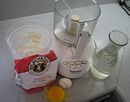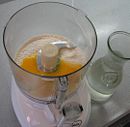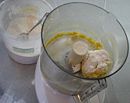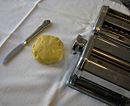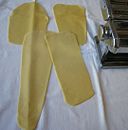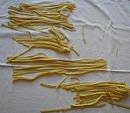Tagliatelle: Difference between revisions
imported>Hayford Peirce No edit summary |
imported>Hayford Peirce (added captions; now Stephen can work his magic on this whole gallery if he wants to) |
||
| Line 8: | Line 8: | ||
|caption= A typical homemade preparation of tagliatelle | |caption= A typical homemade preparation of tagliatelle | ||
|width=130 | |width=130 | ||
|lines= | |lines=5 | ||
|Homemade Tagliatelle 01.jpg| | |Homemade Tagliatelle 01.jpg|The ingredients are flour, eggs, and, possibly, a little water | ||
|Homemade Tagliatelle 02.jpg| | |Homemade Tagliatelle 02.jpg|The ingredients in a food processor | ||
|Homemade Tagliatelle 03.jpg| | |Homemade Tagliatelle 03.jpg|Processing until the ingredients form a ball | ||
|Homemade Tagliatelle 04.jpg| | |Homemade Tagliatelle 04.jpg|Ready to be put through a pasta machine | ||
|Homemade Tagliatelle 05.jpg| | |Homemade Tagliatelle 05.jpg|Using the widest thickness | ||
|Homemade Tagliatelle 07.jpg| | |Homemade Tagliatelle 07.jpg|After the first time through the machine | ||
|Homemade Tagliatelle 08.jpg| | |Homemade Tagliatelle 08.jpg|On the left, after 20 times through the machine | ||
|Homemade Tagliatelle 09.jpg| | |Homemade Tagliatelle 09.jpg|Beginning to use a narrower thickness | ||
|Homemade Tagliatelle 12.jpg| | |Homemade Tagliatelle 12.jpg|Rolled through the machine to #3 or #4 thickness | ||
|Homemade Tagliatelle 13.jpg| | |Homemade Tagliatelle 13.jpg|Cutting, although this is actually fettucine width | ||
|Homemade Tagliatelle 14.jpg| | |Homemade Tagliatelle 14.jpg|Drying the cut pasta | ||
|Homemade Tagliatelle 15.jpg| | |Homemade Tagliatelle 15.jpg|Boiling the pasta | ||
|Homemade Tagliatelle 16.jpg| | |Homemade Tagliatelle 16.jpg|Buttered, and ready to eat, but without sauce | ||
}} | }} | ||
</center> | </center> | ||
Revision as of 18:08, 13 February 2008
Tagliatelle is a well-known form of pasta that originated in the Emilia-Romagna region of northern Italy, where it is particularly known as being the classic accompaniment to Bolognese sauce. A single piece is a long, flat ribbon indistiguishable from fettuccine except for its slightly greater width of about 1/4th of an inch when cut and expanding up to nearly 1/2 of an inch when cooked. When made at home, as it typically is in Italy, it is too wide to be made in a household pasta machine and must be cut by hand. The noted food-writer Marcella Hazan says that Emilia-Romagna "enjoys uncontested recognition" as the birthplace of Italy's "finest" homemade pasta,[1] although the world-renowned spaghetti is not one of the local specialties. The basic homemade dough for tagliatelle, she says, consists only of eggs and soft-wheat flour, with spinach or Swiss chard being permitted for making green pasta. The homemade version, she notes, is "not as chewy as good factory pasta" and has "the capacity of absorbing sauces deeply."[2] Although spaghetti bolognese has become a worldwide standard, in Italy Bolgonese sauce is almost always served exclusively with tagliatelle.
| A typical homemade preparation of tagliatelle | ||||||||||||||||||||||||||
| ||||||||||||||||||||||||||
References
Sources
- Essentials of Classic Italian Cooking, by Marcella Hazan, Alfred A. Knopf, New York, 1992, ISBN 0-394-58404-X
